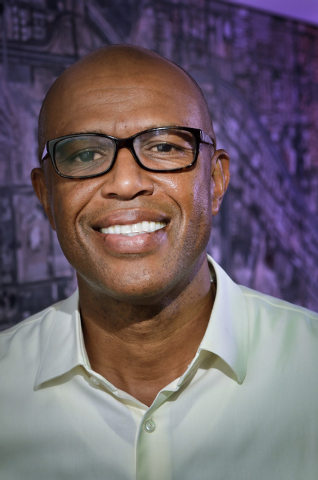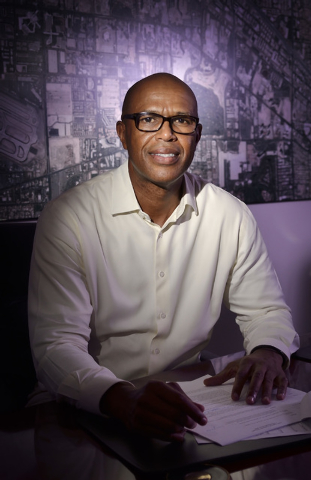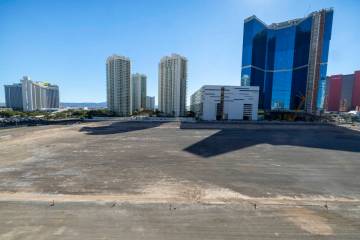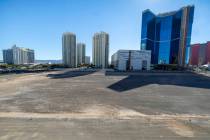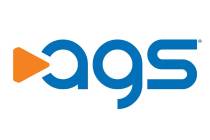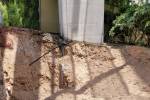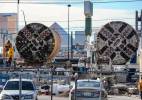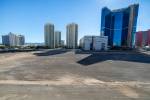Monorail chief strives to keep everyone on track
Curtis Myles commands a presence when he enters a room, whether it’s with his 6-foot-6-inch frame, his broad smile or his infectious laugh.
As president and CEO of the Las Vegas Monorail Co., he’s a member of a committee of transportation shareholders that will guide Southern Nevada’s strategy to move 40 million tourists annually into and around the Strip in the future.
Myles has plenty of transportation experience. Before joining the monorail company, he worked for a Denver-based trucking company, McCarran International Airport and as deputy general manager of the Regional Transportation Commission of Southern Nevada, the agency steering the transportation plan.
He’s happy to be a part of the team and strongly believes in teamwork having played college basketball for Colorado State University and high school basketball for Western High School.
Question: How did you begin with the Las Vegas Monorail Co.?
Answer: I was working at the Regional Transportation Commission of Southern Nevada and we had a meeting with the monorail team of contractors about the extension of the monorail line downtown. From then on, I was a part of the project implementation team. I had followed the monorail because we (RTC) had an interest in it and we were going to help fund it. We were going to provide not only RTC formula-based grant money, but also seeking a full-funding grant agreement for the extension. I was also involved in acquiring the Max and Deuce buses before taking the position with the monorail company. The RTC was working on that when I came, but they had not yet selected the vehicles.
Question: As the head of the monorail company, you have a seat at the table of a group that’s developing a multimodal transportation plan for the Las Vegas Global Business District. Why is that important?
Answer: The study is important because we need to bring Las Vegas’ transportation mobility infrastructure into the 21st century. We need to update, just as we update other things in the resort corridor, like rooms, casino floors and convention facilities. If we’re going to compete globally with other cities, we have to catch up. ... It’s not only important to understand what we need to do to stay at the top of the list, but it’s going to be important to understand how we go forward and fund those things.
Question: How do things stand now?
Answer: We’re nearing the completion of the first phase of the plan. There are four phases. We’ll start the second early this fall. We’re framing and trying to understand the problem right now. Next, we’ll put together some of the solutions. To the public, it seems easy. More lanes, more rail, more buses, more cabs. Just put them out there and you’re done. It’s more complicated than that because we have to address some very specific movements in large numbers and we have to do it very carefully.
Question: You and others have characterized these meetings as an exercise in teamwork. How is it working?
Answer: I’ve never been involved in a study like this where you have such seemingly diverse interests coming together and working on a problem. I think the reason is that we’re not just competing with the neighbors next door. We’re competing around the world and realizing that we are behind in terms of facilities.
Question: You know a little something about teamwork, having played collegiate sports. Tell us about the basketball career at Colorado State.
Answer: I went to Colorado State after playing high school basketball at Western High. I went there in June 1981 and in December 1981, I broke my knee. I rehabbed and then in June 1982, I broke it again. That’s how I started my basketball career. Broke my knee twice and dislocated my pinkie. So the first 24 to 30 months of my basketball career was spent in the training room. I finally got in a real game after 30 months.
Question: How has college sports helped you in your career?
Answer: The first thing you realize is that everybody has a role. To have a successful team, everybody has to work in the same direction. But in order for everybody to work in the same direction, everybody has to understand their role. If each player on the team performs their role well, you don’t need a bunch of superstars, just people that want to work. That’s the single biggest thing you can take from being in a team sport. If everybody tries to play one role, it won’t work and the team you’re playing against is going to take advantage because they know they have you at a disadvantage playing out of position. The good teams, the champions, realize that everybody has a role.
Question: Does the popularity of sports play into how you develop transportation in a community?
Answer: It does. One of the things you realize at age 51 is that not everybody sees things the way you see it. ... When people come together to solve a problem, you have to all be speaking the same language. If one of your players is using football terminology to set a basketball play, hopefully everybody on the team has played football. ... One of the biggest challenges — and for us, one of our advantages — is that we understand that everybody has to be talking the same language in understanding the problem and the challenge we face in developing this infrastructure. Get everybody on the same page first. ... It’s the same thing in sports. If the challenge is to beat the other team and you need wide receivers and quarterbacks and guys who can block, don’t run out there with a bunch of running backs. It’s not going to work. In our case, we need a quarterback so the RTC is our quarterback.
Question: Obviously, a monorail link to the airport is still a consideration.
Answer: Whatever happens with the Las Vegas Monorail has to be a part of the bigger business plan. If we go to the airport, if we go to the west side of the Strip, if we go downtown, if we establish a location at UNLV, it all has to be a part of the bigger plan.
Question: Do you see a day when Strip workers park on the periphery and ride the monorail to work?
Answer: I do and I hope that day is sooner rather than later. I see a day where our system is not only a system that is used to move around a corridor that is connected to 8 million square feet of convention space and 100 restaurants and venues from hotel rooms and the airport, but also as an integrated system to take a bus or light-rail system to one end of our system or the other and get on and go at a relatively inexpensive cost, maybe $1 or maybe for free, for Strip workers to get to and from their jobs.
Question: Did the monorail’s original developers make a mistake by not pushing for a track along the center of the Strip instead of a route along the back of the house?
Answer: Excellent question. It’s a hard question because it seems very obvious to people who aren’t in the transportation business that that is the best place for it to be. The challenge with that is that the Strip has become iconic in the way that it looks. I’m not going to say that they made a mistake or that it was an oversight. I am going to say this: I was born and raised here, I’ve seen the Strip and how it’s developed and I get how people feel when they are there. It’s a destination in and of itself. ... So whatever you do, whether it’s an elevated monorail or an at-grade light rail a streetcar or whatever, you need to be very, very careful that you understand that feeling that has been created and that you do nothing to make it deteriorate.
Question: Money has always been the issue of building an extension of the monorail. With the economy coming back, do you see that changing?
Answer: I don’t see money not being an issue. It’s always going to be an issue. I think it’s less of an issue now than it was two years ago or four years ago. There are programs out there that we can participate in at the federal level today. There are entities out there that are willing to invest in the monorail. Historically, we’ve always looked at funding projects in the United States domestically. But now, there’s a lot of interest around the world in investing in U.S. infrastructure, especially transportation. So we’re not just looking domestically, we’re looking internationally.
Contact reporter Richard N. Velotta at rvelotta@reviewjournal.com or 702-477-3893. Follow @RickVelotta on Twitter.
NEVADAN AT WORK
Name: Curtis Myles
Age: 51
Occupation: President and CEO, Las Vegas Monorail Co.
Quote: "When people come together to solve a problem, you have to all be speaking the same language. If one of your players is using football terminology to set a basketball play, hopefully everybody on the team has played football. If they haven’t, everybody else isn’t going to know what they’re talking about."
VITAL STATISTICS
Name: Curtis Myles III
Age: 51
Family: Three daughters, 25, 24 and 4
Occupation: President and CEO, Las Vegas Monorail Co.
Education: Bachelor of Science degree in economics from Colorado State University, 1981; master’s degree in economics from University of Nevada, Las Vegas, 1996.
Job History: Northwest Transport, Denver; McCarran International Airport, 1991-2002; Regional Transportation Commission of Southern Nevada, 2002-05; Las Vegas Monorail Co., 2005-present
Hobbies: Golf
Favorite Book: "The Partner," by Robert Grisham
Hometown: Las Vegas




